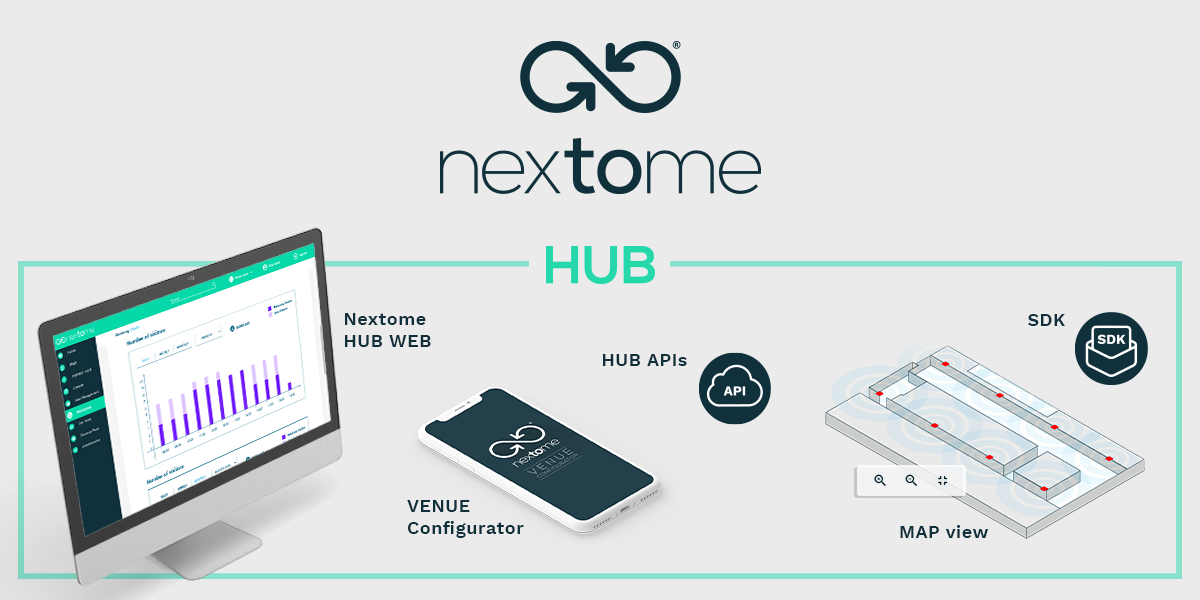Nextome Hub: Exploring the Heart of Our RTLS
In the fast-evolving landscape of indoor positioning and data-driven decision-making, Nextome stands at the forefront with its innovative Nextome Hub. Serving as the core of our indoor positioning system, Nextome Hub brings together cutting-edge technology, infrastructure management, and Business Intelligence capabilities. To shed light on the latest advancements and the future direction of this pivotal tool, we had a conversation with our team.

What is Nextome Hub?
Giangiuseppe Tateo: At its core, Nextome Hub serves as the brain of the Nextome system. It acts as a repository for essential information needed to manage environments utilizing our real time location system. This includes location algorithms for precise positioning, as well as tools for processing valuable metrics for Business Intelligence. Users can access these services through the intuitive Nextome Hub Web interface.
Who is the primary audience for Nextome Hub?
GT: While facility managers are the primary users, benefiting from real-time data and statistical analysis for infrastructure and system oversight, our vision extends beyond this role. We aim to create a unified access point for all stakeholders interested in location-based data. This includes operations managers making data-driven decisions and technology partners integrating location-based services into their offerings.
How has Nextome Hub evolved over time?
GT: Initially, Nextome Hub functioned primarily as a Content Management System (CMS), focusing on infrastructure data management for local mobile SDKs. Over time, it evolved to include geofencing, navigation area management, real-time location data collection, and visualization capabilities. It now offers features for configuring positioning and navigation, web-based tag placement calculations, suggestions for beacon deployment, and real-time visualization of indoor and outdoor data.
What can we expect in the future from Nextome Hub?
GT: Our future developments are twofold. Firstly, we aim to enhance the business intelligence engine to extract more insights from available data while maintaining flexibility for various use cases. Secondly, we plan to expand the management services for indoor spaces. This includes features for booking spaces and resources (like meeting rooms and workstations) and integrating non-positioning related sensors for access control, air quality, and environmental monitoring. Collaborations with other data providers will make Nextome Hub the go-to platform for indoor space management.
What sets Nextome Hub apart as a solution?
GT: Nextome Hub is built on a robust and well-proven system, making infrastructure and map management straightforward and flexible. It is designed to be easily extendable and integrable, allowing us and our technology partners to implement custom services with minimal effort.
What data is collected and how is it displayed?
Laura Notarangelo: The data in Nextome Hub can be categorized into two main types: infrastructure management data and location data. Infrastructure management data encompasses floor plans, device information, points of interest, recommended routes, and geofencing zones. Users can view and manage this data on a map within the Nextome Hub. Location data, generated by the Nextome computing engine, can be displayed through a blue dot on facility plans or in tabular form.
How long is the collected data retained, and what is its purpose?
LN: Data retention duration is customizable to meet client needs and ensure GDPR compliance: daily deletion procedures are in place to align with specific use case requirements and users can also choose between individual or aggregate data storage. In the latter case, individual device details are obscured, but the data remains useful for creating analysis dashboards that support decision-making.
What insights can be derived from the data, and what's on the horizon?
LN: The data within Nextome Hub can be explored through interactive filtering based on time periods, rooms, maps, objects, or individuals, enabling KPI monitoring from various angles. For example, users can analyze occupancy trends in specific areas or track the number of people present in the entire facility or specific rooms over time. These measures can also be presented as percentages, facilitating data comparisons.Additionally, we're working on aggregating information from our technology services, such as navigation and notifications, to provide statistics related to geofencing events, points of interest searches, or common routes. The structured nature of our data allows us to continuously evolve and tailor Business Intelligence elements, creating custom graphs, visualizations, and metrics for each unique use case.
With Nextome Hub's ongoing evolution, it's poised to remain a pivotal tool for businesses and organizations seeking to harness the power of indoor positioning and data-driven decision-making.
